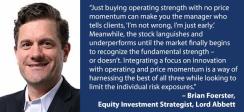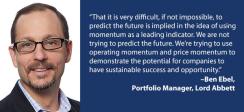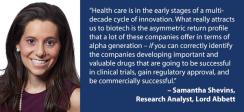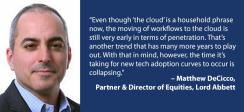With apologies to whoever invented the wheel and Thomas Edison, innovation is happening at a more rapid clip today than at any other time in human history. Daily life is being changed before our very eyes by the unprecedented speed at which information can be processed, the seeming ubiquity of e-commerce, breakthroughs in drug therapy, and more. All of this is also creating opportunities for investors – so much so that a team of equity investment professionals at Lord Abbett is dedicated solely to strategies that invest in innovation. The team believes that innovation should be considered its own asset class, and that stocks of high-innovation companies may need to be viewed as the new core in asset allocations. The good news for investors is that many areas of innovation have only scratched the surface of market penetration.
II recently spoke with four members of the innovation equities collaboration at Lord Abbett about the disruptive innovation that is generating revenue and earnings growth many multiples higher than that of the overall equity market – and what it all means for investors. Participating in the conversation were:
- Brian Foerster, Equity Investment Strategist
- Ben Ebel, Portfolio Manager
- Samantha Shevins, Research Analyst
- Matthew DeCicco, Partner & Director of Equities
When you say innovation is its own asset class, how literally should investors take that? And what does it mean for their portfolio?
Brian Foerster: Quite literally. Over the last 20 years, the stocks of technologically innovative companies have emerged from the shadows of speculative investment into broad daylight, representing the most dominant areas of the global economy. And yet they remain grossly underestimated. We think the traditional growth benchmarks do not give investors the best exposure to this critical area of the economy. One reason for this disconnect is that the traditional growth/value framework has always been driven by one key metric: price-to-book cheapness. That valuation metric is typically the largest weighting in constructing style indexes. While that approach was never perfect, it was sufficient 40 years ago in a production-based economy where most of a company’s assets were physical – plant, property, and equipment. However, the vast majority of company assets today are intangible and not reflected in book value. That could be one reason why value as a style has struggled so much. Some value stocks that have become vulnerable have a lot of strategy debt but look cheap on the surface based on their price-to-book valuation. They have a lot of physical capital that was once a great competitive advantage, but now in many cases has become a liability. Think about brick-and-mortar retail. Is it better to have a store in every neighborhood around the world, or to have an e-commerce presence that anyone can use and requires much less overhead? Innovation forced that change.

It sounds like investors need to look at equities through an entirely new lens.
Foerster: A framework of innovation, vulnerability, and durability is a better way to think about the global economy, and therefore equities. Within that framework, innovative companies that are asset light and invest heavily in R&D stand out when there is something about their product or service that is disruptive to many other industries or companies. That disruption drives vulnerability.
Companies that are poorly positioned to the threat of innovation, and don’t quickly respond, are headed for a long, secular decline – value traps that appear cheap, but even if they’re trading at book value could still be very expensive if they’re headed for zero. We’re advocating to get out of those names. When you look under the hood of your value manager, make sure that you’re owning durability rather than vulnerability. We think institutional allocations to innovation should be sizable, and almost equal in weight to that concept of durability. Whether that’s scaled to underlying volatility is based on investor needs, but we’re saying we could be seeing a more Darwinian decade ahead with more distinct winners and losers. Having that larger exposure to innovation balanced with traditional value exposure makes sense.
Does the focus on innovation add diversification to a portfolio?
Foerster: Yes. For starters, you’re owning the very companies that are causing value so much pain and creating disruption and displacement risk. In the type of strategies that we run – which have exposure to innovation, and a focus on identifying operation and price momentum – it’s not a matter of finding innovation, putting your feet on the desk and saying, “Let it run for 10 years.” Our experience has been that you need to first find great innovators, but it is also just as important to identify those with operating momentum. That also means it is critical to sell the stocks of companies facing new competitive threats or those with slowing growth rates. We use both operating momentum at the company level and price momentum of the underlying stock to find opportunities that we think represent justified momentum.
The momentum factor has historically been very negatively correlated to the value factor. So, an innovation-focused portfolio that employs momentum effectively can be a strong diversifier to value strategies.

Would you say your view of innovation is a critique of value?
Foerster: No, but it does require an investor to look at value differently. It’s not just seeking out absolute cheapness or using one metric to formulaically identify a value stock – which is kind of what value devolved into over 70 years. Instead, it’s about looking at free cash flow and dividend growth as potential signals of existing or future quality, and identifying whether these companies have strong competitive moats. Value is something that’s not going to go away, but it does need to return to something closer to the original Graham-Dodd concept of it – and adapt to the fact that innovation is wreaking havoc.
Ben Ebel: We have very successful value strategies at Lord Abbett, and they run deep in our roots as a firm. We are far from anti-value. It’s our observation, however, that the value manager of the next decade is going to do an increasingly good job of making the distinction between companies that are cheap and durable, and those that are experiencing vulnerability because of how rapidly innovation is impacting not just the sectors that we invest in, but also the sectors that our value colleagues invest in.
In an age of rapid innovation driven by technology, everyone wants to invest in the next big thing before everyone else knows it’s the next big thing. How do you keep up with everything that’s going on in innovation so that – at least some of the time – you can be a step ahead from an allocation perspective?
Ebel: That’s a question that gets to the heart of our philosophy of having innovative companies that are realizing their potential, and having that sync with the market’s realization of that potential, too, generating stock price momentum. We view it as Venn diagram – if you can get all three of those things in your stocks, you’re building a portfolio of names that can drive expectations of earnings growth, in turn justifying the premiums that drive outperformance.
That it is very difficult, if not impossible, to predict the future is implied in the idea of using momentum as a leading indicator. We are not trying to predict the future. We’re trying to use operating momentum and price momentum to demonstrate the potential for companies to have sustainable success and opportunity. You want a healthy balance of being able to get something that the wisdom of the crowd recognizes is going well, but not quite how well.
Foerster: We’re investing at the center of the Venn diagram Ben described, looking for companies that are very innovative and operating at a high level, which is confirmed by price momentum. That will lead us to either industries or trends. For example, we’ll find a number of companies that meet our criteria in cloud computing or biotechnology, and we’ll end up with a large weight in those industries or megatrends. Looking at opportunities one stock at a time allows us to identify trends and size them into the portfolio at the right time.
Sticking with that thought of keeping up with the opportunities as they emerge, are some opportunities less obvious than others?
Samantha Shevins: Innovation in the tech sphere is tangible to nearly everyone because the products and services are in their homes, cars, and smartphones every day. Innovation is less apparent in industries such as biotech, to borrow an example from what Brian was just talking about. Unless you’re embedded in the healthcare system, you’re probably unaware of how new tools and analytical methods have greatly reduced drug development time.
The SARS-CoV-2 virus was first described in the media in late 2019 and its genome was sequenced by January 10, 2020. Within a few weeks of that date, pharmaceutical companies started designing new drugs and vaccines against the virus. At the one-year anniversary of a pandemic that’s altered all of our lives, we have three vaccines approved in the U.S., and companies are already in the lab working on next generation vaccines to cover variants. That was all possible because of genomic sequencing. It took $1 billion to achieve the first human genome sequence. Today, a person’s genome can be sequenced in a matter of days and it costs less than $1,000. Combine that with new analytical methods and we now have tremendous insights into understanding causes of diseases and how to create drugs to target them.
Matthew DeCicco: The human genome project was an incredible success and was completed in 2003, so a lot of the tools that Samantha referenced have evolved in the time since then. Another way of looking at it is that the return on research and development has improved. We’ve been invested in this sector for the better part of the last decade, so the momentum was apparent to us well before COVID-19 triggered the pandemic.

As you mentioned, the pandemic really put biotech innovation on display. What are some other reasons institutional investors should be in biotech?
Shevins: We believe health care is in the early stages of a multi-decade cycle of innovation. What really attracts us to biotech is the asymmetric return profile that a lot of these companies offer in terms of alpha generation – if you can correctly identify the companies developing important and valuable drugs that are going to be successful in clinical trials, gain regulatory approval, and be commercially successful.
There are many aspects you have to feel comfortable about to risk adjust the odds of success. We have a rigorous process for identifying companies that are creating first-in-class or best-in-class drugs that might offer meaningful benefits to patients. We’re not looking for the tenth drug in a category that’s already commoditized. We prefer drugs that are developed for diseases where the underlying biology is elucidated or at least generally well understood, as that tends to increase the odds of success in clinical trials for those drugs. And, we want to see a clear and efficient pathway to FDA approval.
As part of our process we also look at not only how the R&D dollars are spent, but also to see that the whole development is in capable hands. We prefer experienced management teams that have track records of success from designing clinical trials to navigating the FDA regulatory process. A track record of success further enhances the odds of a drug making it across the finish line.
DeCicco: There are situations where we do all the things that Samantha just described, and we are early – we beat a big jump in the stock price. But it might be that that big jump in the stock price actually makes us more enthused about the outlook going forward. In other words, if a spike in the stock price is caused by better-than-expected results in a clinical trial, the stock might become cheaper because the odds of success or the size of the company’s market share might have increased as a result. By following the process that Samantha just laid out, we are sometimes in stocks before they have a big move, and at other times we’re adding to a stock even after they have a big move because we anticipate that there’s more upside ahead.
Shevins: Because a lot of these companies don’t have revenues or earnings, we gauge their progress by analyzing their clinical data relative to expectations. If the data looks better than expected, or if the label gets its assets to a broader market once it’s approved, the potential increases and the risk decreases. As a result, we will add to those investments on the way up because we feel more confident.
How do you apply a similar rigor in the tech sector?
Ebel: I remember visiting one of the largest software companies in the world back in the early 2000s, and I was struck at how every engineer had four computers in their office. I asked the CFO about the ability to constrain some of the resources, and he just shrugged and said, “Oh, you know, when an engineer wants something, the CEO okays it.” There clearly wasn’t a process for allocating budget dollars in a way to fund what management deemed the best projects so that they could achieve the kind of depth that results in the revenue rewards of R&D. The point is that having an allocation process is very important. I like to think about things from the perspective of the CFO of each of these companies, making the same sort of R&D and marketing allocation decisions they would. If you’re too early on an idea you’re not optimizing that allocation, and obviously you don’t want to be too late. Having a process to capture the balance for when the timing is right is really important. Great stocks come from credible, successful management teams, and when that comes together and visible in performance and price momentum, we have what we seek.
DeCicco: The first part of the Venn diagram we’ve mentioned is a four-way qualitative assessment of a company’s potential – the model, the management, the industry conditions, and the competitive advantage. The qualitative assessment of a management team is based on experience and interactions we have with C-suite individuals over the course of many years. In a typical year, our team has at least 500 meetings with management teams at companies we’re invested in or considering investing in.

In a recent presentation in which each of you participated it was mentioned that e-commerce and cloud computing have really just scratched the surface in terms of penetration, at something like 20%. It is mind-boggling that there is still so much opportunity there. Beyond biotech, where else do you see fresh opportunity?
DeCicco: That statistic is an eye-opener, especially regarding e-commerce – even more so when you consider how big 2020 was for e-commerce penetration. The takeaway is that a lot of investible innovation trends are still in the early phases of adoption. Another example is streaming television. About 30% of TV viewing by people under 45 is now done via streaming, but only 8% of TV advertising budgets go to streaming. Based upon its nascency as a market, there’s a tremendous amount of growth potential in the ecosystem around streaming television advertising.
And there is still room to grow even in cloud computing? It seems as if we’ve been talking about that forever.
DeCicco: Even though “the cloud” is a household phrase now, the moving of workflows to the cloud is still very early in terms of penetration. That’s another trend that has many more years to play out. With that in mind, however, the time it’s taking for new tech adoption curves to occur is collapsing. For example, televisions or automobiles took 30 years to get to 30% household penetration in the U.S. The internet and mobile phones both got to that 30% level in less than 10 years. New markets are evolving rapidly, and their market penetration is happening faster than has historically been the case.
Still, we’re talking about a time horizon where compounding becomes a major benefit for investors, correct?
DeCicco: When you can identify companies or trends that can grow for 40% for a long period of time you get the benefit of compounding – and the power of compounding over 10 years is a meaningful value capture for investors. For example, $1 dollar compounded at 40% for 10 years is worth $28, whereas $1 compounded 10% for the same length of time is worth $2.50.
Ebel: If you look at the innovative companies people were betting on five years ago, what was largely left unexploited was the bottleneck they created someplace else in the ecosystem. There wasn’t an appreciation that an infrastructure was being created – both a footprint as well as a depth – and that cloud software companies could piggyback off of that and potentially take their growth from 15% to 30% or 40%.
Today, companies that adopted that cloud software are seeing the benefits. For example, in the current environment, an athletic apparel retailer can get more productivity out of its online store or call center agents working from home rather than in a central place – and still be able to keep comps at a very high level. That, in turn, creates further bottlenecks somewhere within the ecosystem, and companies that spent R&D dollars on products and building channels via sales and marketing are able to see a return off of that.
Earlier you mentioned the qualitative assessment you make of a company’s potential – the Venn diagram. How does your investment process proceed from that point?
DeCicco: The second step is fundamental analysis that’s very specific and designed for evaluating innovative, high-growth companies to identify operating momentum. And we want to see that confirmed with the quantitative assessment of a company’s relative and absolute price momentum. We think each part our process adds a tailwind to our returns, and the process is enhanced by our eight-person team. Two members of the team have 30-plus years of investing experience, and five have 20-plus. It’s a very experienced group, and that really showed in the way we navigated 2020.
What does the range of stocks you cover look like?
DeCicco: We cover innovation stocks from micro to mega, from $1 billion companies to $2 trillion companies. That gives us a unique perspective on the competitive landscape of the entire innovation ecosystem. That is possible in part because of our platform. Our team is agile and solely focused on identifying and investing in innovative companies, but we benefit from being part of a much larger organization. We have a tremendous fixed-income franchise which provides us with it a lot of economic insight, for example. And we have access to risk management tools and quant tools, as other examples – all the tools we need to be successful, combined with the ability to operate like a boutique.
It all begs the question: Why? Why do you do everything you’ve described when any one aspect of your process could be a successful equity strategy on its own?
Foerster: The short answer is that you need to manage risk to keep clients invested. Just trying to identify the long-term winners in innovation is difficult given the intense competition in these industries. As Ben said, we are not trying to predict the future. And even the big long-term winners can sometimes experience short-term drawdowns – big ones. Think of Amazon back in 2000–2002, it went down 95% before resuming its incredible run. Netflix fell nearly 80% in 2012, Tesla has fallen 40% or more multiple times. They all proved to be big winners over the long run, but those types of drawdowns are difficult to stomach while they are happening and can cause clients to sell at the worst possible time.
Then you look at the momentum factor by itself. It has proven to be one of the most powerful and best-performing factors over the long run. But what is it known for most? Momentum crashes. Blindly buying price momentum without fundamental justification is also an excessively risky approach in the near term. We believe momentum is powerful in capturing the under-reaction bias, and that buying strength – as Matt described with biotech – is a great source of returns. Just buying operating strength with no price momentum can make you the manager who tells clients, “I’m not wrong, I’m just early.” Meanwhile, the stock languishes and underperforms until the market finally begins to recognize the fundamental strength – or doesn’t. We believe integrating a focus on innovation with operating and price momentum is a way of harnessing the best of all three while looking to limit the individual risk exposures.
Last, and most important, we believe the underlying technology of everything we’ve been talking about continues to be underestimated. Growth rates of technological progress and adoption rates are often exponential, and humans tend to think more linearly. We have seen a lot of forecasts for innovation over the last 20 years proven to be overly conservative and wrong. Our process is fairly unique because we focus so much on the dynamism in this space, not just static forecasts.
Learn more about making innovation a key part of your investment strategy.
THIS MATERIAL IS FOR THE USE OF INSTITUTIONS, INSTITUTIONAL CONSULTANTS, AND FINANCIAL PROFESSIONALS. IT IS NOT INTENDED FOR, AND SHOULD NOT BE USED WITH, RETAIL INVESTORS.
IMPORTANT INFORMATION
A Note about Risk: The value of investments in equity securities will fluctuate in response to general economic conditions and to changes in the prospects of particular companies and/or sectors in the economy. While growth stocks are subject to the daily ups and downs of the stock market, their long-term potential as well as their volatility can be substantial. Value investing involves the risk that the market may not recognize that securities are undervalued, and they may not appreciate as anticipated. Smaller companies tend to be more volatile and less liquid than larger companies. Small cap companies may also have more limited product lines, markets, or financial resources and typically experience a higher risk of failure than large cap companies. However, larger companies may have slower rates of growth than smaller successful companies.
The information provided is for general informational purposes only. References to any specific securities, sectors or investment themes are for illustrative purposes only and should not be considered an individualized recommendation or personalized investment advice, and should not be used as the basis for any investment decision. This is not a representation of any securities Lord Abbett purchased or would have purchased or that an investment in any securities of such issuers would be profitable. Statements concerning financial market trends are based on current market conditions, which will fluctuate. There is no guarantee that markets will perform in a similar manner under similar conditions in the future. Past performance is not a reliable indicator of future results.
This commentary may contain assumptions that are “forward-looking statements,” which are based on certain assumptions of future events. Actual events are difficult to predict and may differ from those assumed. There can be no assurance that forward-looking statements will materialize or that actual returns or results will not be materially different from those described here.
Intangible capital may include non-physical assets such as research and development spending, software, brands, and other intangible assets.
Intellectual capital refers to the intangible assets that contribute to a company's bottom line. These assets include the expertise of employees, organizational processes, and sum of knowledge contained within the organization.
Price-to-Earnings Ratio: Stock analysts calculate a price-to-earnings ratio by dividing a stock's current price by its earnings per share on a trailing 12-month basis. A forward price-to-earnings ratio is calculated by dividing a stock's current price by estimated future earnings per share.
Research and development (R&D) expenses are associated with the research and development of a company's goods or services. A company generally incurs R&D expenses in the process of finding and creating new products or services.
The information provided is not directed at any investor or category of investors and is provided solely as general information about Lord Abbett’s products and services and to otherwise provide general investment education. None of the information provided should be regarded as a suggestion to engage in or refrain from any investment-related course of action as neither Lord Abbett nor its affiliates are undertaking to provide impartial investment advice, act as an impartial adviser, or give advice in a fiduciary capacity. If you are an individual retirement investor, contact your financial advisor or other fiduciary about whether any given investment idea, strategy, product or service may be appropriate for your circumstances.
The opinions in the preceding commentary are as of the date of publication and subject to change based on subsequent developments and may not reflect the views of the firm as a whole. This material is not intended to be legal or tax advice and is not to be relied upon as a forecast, or research or investment advice regarding a particular investment or the markets in general, nor is it intended to predict or depict performance of any investment. Investors should not assume that investments in the securities and/or sectors described were or will be profitable. This document is prepared based on information Lord Abbett deems reliable; however, Lord Abbett does not warrant the accuracy or completeness of the information.






